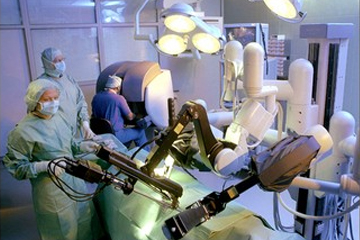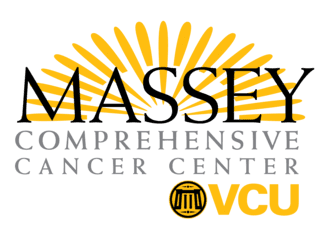da Vinci state-of-the-art robotic platform
Massey physicians now offer the latest in robotic surgery technology with the addition of the da Vinci Surgical System. In the hands of our surgeons, the da Vinci state-of-the art robotic platform enables a minimally invasive option for complex and delicate surgical procedures.
For the patient, benefits of robotic surgery may include:
- Significantly less pain
- Less blood loss and scarring
- Shorter recovery times,
- A faster return to normal activities
- Better clinical outcomes
Robotic surgery for staging and treating gynecologic cancers

“Compared to traditional laparoscopic surgery, the robotic platform allows for more fine movements, precision and control with the use of wristed instruments and an improved video feed.” says Stephanie A. Sullivan, M.D., gynecologic oncologist at Massey.
Robotic surgery offers several advantages for eligible patients with gynecologic cancers and is an especially helpful tool for complex pelvic surgeries. Combined with state-of-the-art fluorescent dyeing, it can allow for the removal of fewer lymphnodes in the diagnosis of endometrial cancer, leading to faster recovery and fewer complications. It can also be beneficial in removing early cervical cancer and ovarian tumors, performing complicated biopsies and conducting complex surgeries on localized tumors.
Advanced surgical option for head and neck cancer patients
Continuing to advance robotic surgery as a minimally invasive treatment option, Massey physicians are now performing transoral robotic surgery.
This new treatment option is for patients with cancers involving the tonsil, base of the tongue, the pharynx and the larynx. Massey is one of only a handful of cancer centers in the country, and the first in the region, to use this technique.
Approximately 45,000 Americans are diagnosed with head and neck cancers each year. Tumors are often treated by a combination of surgery, radiation therapy and chemotherapy. In many cases, surgery offers the best chance of cure; however, conventional surgery may require a large incision involving splitting the lip and/or the mandible to gain access to the tumor. This often results not only in a cosmetic deformity, but can also result in significant speech and swallowing problems.
“The main benefit of robotic surgery to treat oral cancers is the ability to address a tumor directly at the site, limiting tissue damage,” said Nadir Ahmad, M.D., surgeon in the Department of Otolaryngology, Head and Neck Surgery. “The conventional method requires surgery through the neck, lip or jaw to access the tumor site. With the da Vinci robotic system, we can use a minimally invasive technique through the mouth using the robot’s superior magnification and precise wrist-like action to get to an area without the need for large and disfiguring incisions.”
“Patients treated with the transoral robotic surgery will generally have shorter hospital stays and will be able to leave within days after surgery, compared to a week or more in the hospital after conventional surgery,” said Dr. Ahmad. “Patients will more likely be able to swallow within days following the robotic surgery. It often takes patients months after conventional surgery to regain the ability to swallow, and sometimes they are dependent on a feeding tube long term.”
Urologic Tumor Center on cutting edge with use of da Vinci robotics
Lance Hampton, M.D., co-director of Massey’s Urologic Tumor Center, agrees. “It’s a huge plus for our patients,” he says.
“The big challenge in prostate cancer surgery is sparing the nerves,” explains Dr. Hampton. “The da Vinci provides magnified 3-D vision, which greatly improves my ability to work around the nerves, minimizing risk and preserving the patient’s sexual function and continence.
“During kidney surgery, the robotic platform allows me to fully appreciate the intricate 3-D spatial relationships of large blood vessels around the kidney in order to minimize blood loss,” he adds.
